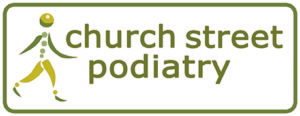OPENING TIMES
Monday / Tuesday / Friday
9.00 am – 6.00 pm
Every Other Saturday
From 9.00 am
Evening appointments available
by arrangement
Telephone or email us for an appointment.
Or pop-in the next time you’re in town.
We’re only a five minute walk from Godalming Station.
01483 428680
PODIATRY AND CHIROPODY – COMMON CONDITIONS
A BRIEF LOOK AT SOME OF THE FOOT PROBLEMS WE REGULARLY CARE FOR
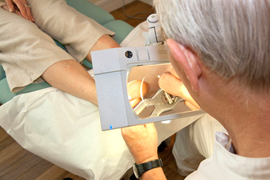 We diagnose and treat a wide range of complaints which can vary from simple everyday problems through to chronic debilitating conditions.
We diagnose and treat a wide range of complaints which can vary from simple everyday problems through to chronic debilitating conditions.
Here we outline some of the more regular foot pathologies that will trouble most of us at some stage in our lives. Some conditions only require a very simple treatment which with additional care taken directly by the patient at home are easily resolved. Others can be more persistent or require more complex remedial action. Whichever course of action is required to treat your particular condition we will provide a highly professional service based on many years of experience.
Quite often you will have been referred to us by your GP or another health professional. We work closely with local doctor’s surgeries and the health services at all levels.
A common question we are asked is ‘what is the difference between podiatry and chiropody?’. In essence there is no difference as practitioners operating under each term are qualified to diagnose and treat abnormailities of the lower limb. In the UK the term ‘podiatry’ officially replaced chiropody in 1993.
BUNIONS
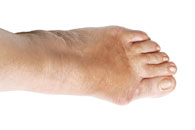 Signs and symptoms. A true bunion is the enlargement of the first metatarsal joint with an overgrowth of bone. The metatarsal bones are the group of five long bones in the foot. A false bunion is where the first toe deviates towards the midline of the foot with a resultant enlargement of the first metatarsal joint. This can cause subsequent problems for the adjoining toes.
Signs and symptoms. A true bunion is the enlargement of the first metatarsal joint with an overgrowth of bone. The metatarsal bones are the group of five long bones in the foot. A false bunion is where the first toe deviates towards the midline of the foot with a resultant enlargement of the first metatarsal joint. This can cause subsequent problems for the adjoining toes.
Treatment Bunions can be surgically operated on to apply corrective procedures. Advice can be given to reduce the symptoms through active exercising.
INVOLUTED AND INGROWING TOENAILS
 Signs and symptoms. Involuted toenails are where one or both sides of the toenail curl over into the skin. Can originate from fan-shaped nails. Ingowing toenails are where the skin at the side of the nail becomes broken and results in granulated tissue causing infection, swelling and pain.
Signs and symptoms. Involuted toenails are where one or both sides of the toenail curl over into the skin. Can originate from fan-shaped nails. Ingowing toenails are where the skin at the side of the nail becomes broken and results in granulated tissue causing infection, swelling and pain.
Treatment Practical advice on nailcutting given for long-term management of involuted nails. Once ingrowing toenail growth has been removed monitoring for effective healing on the affected toe. Further surgery may be required to prevent any reoccurence of the condition.
CALLOUSES AND CORNS
 Signs and symptoms. Callouses are caused by friction applied to the foot through footwear and the process of walking generally a common result of wear and tear in the everyday life of your feet. An extreme form is hyperkeratosis, an extreme overgrowth of the top layer of skin.
Signs and symptoms. Callouses are caused by friction applied to the foot through footwear and the process of walking generally a common result of wear and tear in the everyday life of your feet. An extreme form is hyperkeratosis, an extreme overgrowth of the top layer of skin.
A corn is the painful condition resulting from pressure being applied over a bony area.
Treatment. Removal of the hardskin that is causing the symptoms is a straightforward procedure. For persistent corns alleviative padding can be applied to not only reduce symptoms but also prevent reoccurrence.
NAIL THICKENING
 Signs and symptoms.
Signs and symptoms.
There are three types of thickening of nails. Fungal infections can promote thickening to various degrees. Minor trauma to the toe can also act as a trigger. Major trauma can result in extreme thickening presenting as ‘rams horn nails’ (Onychogryphosis)
Treatment. Reduction of the nail through treatment at regular intervals. Practical advice can be given for the ongoing treatment of fungal nails.
FUNGAL INFECTIONS
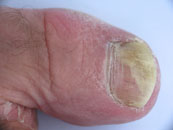 Signs and symptoms. Presents as itching between the toes and may extend on to the top of the foot or onto other parts of the foot. CAn be accompanied by blisters.
Signs and symptoms. Presents as itching between the toes and may extend on to the top of the foot or onto other parts of the foot. CAn be accompanied by blisters.
Treatment. Specialist antifungal spray or cream applied in the surgery and at home.
VERRUCAE
 Signs and symptoms.
Signs and symptoms.
Caused by a viral infection verrucae present as hyperkeratotic lesions particularly in the heel and ball of the feet.
Treatment. The virus that affects the feet to cause verrucae is the human papilloma virus and can respond effectively to various treatments ranging from the appli
HAMMER AND MALLET TOE
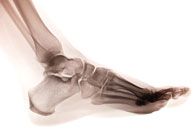 Signs and symptoms. Tend to be distorted at either the last or second joint of the toe and can be caused by slip-on shoes and an imbalance in the flexor and extensor muscles. Can become arthritic.
Signs and symptoms. Tend to be distorted at either the last or second joint of the toe and can be caused by slip-on shoes and an imbalance in the flexor and extensor muscles. Can become arthritic.
Treatment. Specialist advice and guidance on active excercises can help in the early stages, but pallative care and possible referral for surgery may be required
DIABETES
 Signs and symptoms.
Signs and symptoms.
We list diabetes here not as a foot complaint per se but as an indicator of symptoms presenting in your lower limbs. Diabetes is a metabolic condition whereby the body cannot produce enough insulin or cannot utilise the sugars being absorbed by the body. This my affect the body in many different ways from impaired nerve function to poor permeability of blood vessels. This can lead to neuropathy and an increased risk of infection. Your podiatrist should be able to pick up on certain symptoms and advise on seeking specilaist advice.
Various other metabolic disorders and autoimmune conditions can be recognised during close examination of your feet, and appropriate referral made to your GP.
